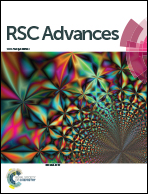An aggregation-induced emission enhancement fluorescent benzoxazine-derived macromolecule: catalyst-free synthesis and its preliminary application for the determination of aqueous picric acid†
Abstract
A tetraphenylethene-containing fluorescent macromolecular benzoxazine derivative (TPE-BOZ) was synthesized via the Mannich reaction under catalyst-free conditions using 4,4′-(1,2-diphenylethene-1,2-diyl)diphenol, poly(propylene glycol)-bis-(2-aminopropylether) and formaldehyde as the starting materials. TPE-BOZ displayed typical aggregation-induced emission enhancement characteristics in ethanol (a good solvent) and water (a poor solvent), which stemmed from the incorporation of tetraphenylethene moieties into its structure. The fluorescence of TPE-BOZ in a high water fraction medium (ethanol : water 1 : 9 v/v) was effectively quenched by the introduction of picric acid with a Stern–Volmer value (ksv) of 1.134 × 107 M−1. The detection limit for picric acid by TPE-BOZ was 4.47 nM. The presence of other common nitrocompounds and solvent residuals did not significantly interfere with the recognition of picric acid by TPE-BOZ. TPE-BOZ can also be used as a solid-state probe to determine picric acid.


 Please wait while we load your content...
Please wait while we load your content...